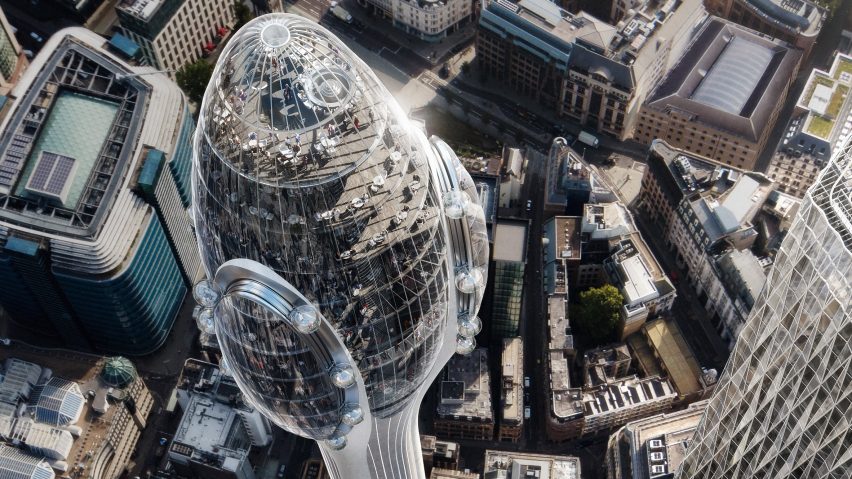Norman Foster says the The Tulip will become a "symbol in it's own right" as the controversial 305.3-metre-high tourist attraction is approved by City of London.
Foster + Partner's design for The Tulip, a concrete shaft topped by glass viewing platforms complete with slides and rotating pods, has been waived through by the City of London's planning committee today.
The supertall visitor attraction was approved following a vote of 18 to seven in favour of the tower.
Norman Foster addresses "inevitable" controversy
The Tulip is planned to sit next to Foster + Partner's Stirling Prize-winning skyscraper 30 St Mary's Axe, also known as The Gherkin.
Norman Foster, who was unable to attend the planning committee personally, said The Tulip could become as iconic as the former building, in a statement seen by Dezeen.
"Like the Gherkin nearly twenty years ago, it is inevitably controversial, like the Gherkin it has the possibility of being a symbol beyond its host city."
Foster the three-time Stirling Prize winner who founded Foster + Partners in 1967 explained how the tower was designed for the public.
"The owner of The Gherkin approached me last year to ask how – as a world symbol of London – could we bring to it a public dimension," said Foster.
"It proved impossible to retrofit the tower, so we proposed a companion structure totally devoted to the public with a generous educational dimension for younger generations. No such facility exists in London – available for its citizens and visitors alike," he continued.
"Aside from being a symbol in its own right, it will add to the cluster of tall buildings that mark the city within a city. Socially, it will broaden the activities beyond its domain of business."
City of London backs planting The Tulip
Critics have argued that the design breaches London's planning guidelines and warned that it could interrupt airport radar systems.
But the decision to approve the tower follows the publication of a 152-page report from the City of London that concluded The Tulip had the potential to become an "architectural icon" for London.
"After a lengthy and robust debate, the committee agreed to approve this truly unique visitor attraction," said committee chairman Chris Hayward.
"One of my key objectives as chairman of the planning and transportation committee has been to enable the continued transformation of the City of London into a place which welcomes members of the public on weekends as during the week. This building has the potential to play an important role in realising our vision of the Square Mile as a vibrant 24/7 city."
Economic value assessed at £1 billion
Officials estimated the "public cultural attraction" will bring in 1.2 million visitors every year.
"As part of the planning application process, The Tulip Project submitted an Economic Impact Assessment by Deloitte, which estimated that The Tulip would offer economic benefits to London of nearly £1 billion in total monetised value by 2045," said The Tulip Project.
This report also estimated the attraction would create 600 jobs during the first 20 years it was in operation. The Tulip also plans to invite 40,000 local state school children and community groups to access educational facilities in its "classrooms in the sky".
A pocket park will be built at the base and there will be a publicly accessible rooftop terrace as well as a sky bar. As part of the conditions of achieving planning the development team promised to limit tickets at peak hours to avoid congestion and put stringent security measures in place.
Now the City of London will submit its resolution to grant planning approval to the mayor of London's office. If approved construction could begin by 2020, with completion due for 2025.
Images courtesy of DBOX and Foster + Partners.

